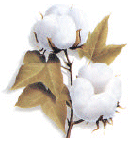
Fiber Profile:
Cotton

Cotton has been cultivated and used in fabrics for over 7,000 years, making it the oldest known fiber in the world. It is versatile, soft, breathable, absorbent, and durable.
Unlike wool and other popular fur-derived knitting fibers, cotton does not cause any allergies, making it an ideal fiber for sensitive knitters.
Origins
The finest cottons are called "Extra Long Staple," or "ELS" cottons. The two most popular ELS cottons are Pima and Egyptian.
True ELS cottons are believed to have come from the Sea Island plant on the Bahama Islands. During his explorations, Columbus is reputed to have taken Sea Island seeds back to England with him.
Egyptian and Pima
In the late 1800s, Sea Island cotton was brought to Egypt and crossed with a local tree cotton. Over time, the plant was inbred repeatedly to produce Egyptian cotton.
Pima cotton was developed in the Southwestern United States in the early 1900s. The name Pima was given in honor of the Pima Indians, who helped raise the first experimental plants in Sacaton, Arizona.
Pima rivals Egyptian cotton in softness and luxuriousness. American Pima is grown in Arizona, California, New Mexico, and Texas. All cotton in the United States is machine harvested.
The Yarns
You'll find cotton alone and blended with nearly every fiber -- natural and synthetic -- on the planet. Because pure cotton yarn is firm and somewhat rigid, manufacturers often blend cotton with another natural or synthetic fiber to add bounce and elasticity.
For example, Rowan blends merino and cotton in its Wool Cotton, while Reynolds mixes alpaca and Pima cotton in Destiny. Cascade takes the bounce concept one step further by blending cotton and elastic in Fixation.
Mercerized
You'll often find cotton yarns that are unusually shiny and strong. This is called "mercerized" cotton. To achieve this shiny texture, the fiber is treated with warm concentrated soda lye. The result is a more silky texture that is particularly good for sheer summer knits.
Organic
Organic cotton yarns have become increasingly popular, although they're still somewhat hard to find. True purists may be interested in the new strains of naturally colored cottons, as well. They come in subtle greys, greens, and browns, naturally derived from the plant without any dying whatsoever. The following sites offer certified organic cotton yarns.
![]() Discuss cotton in our forums
Discuss cotton in our forums


